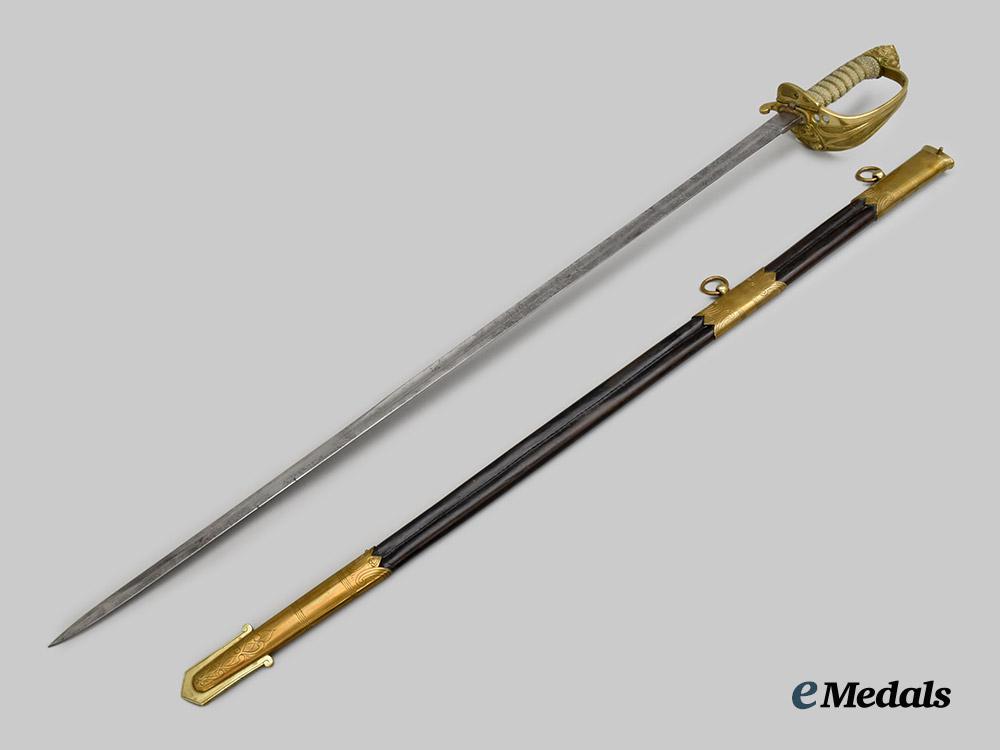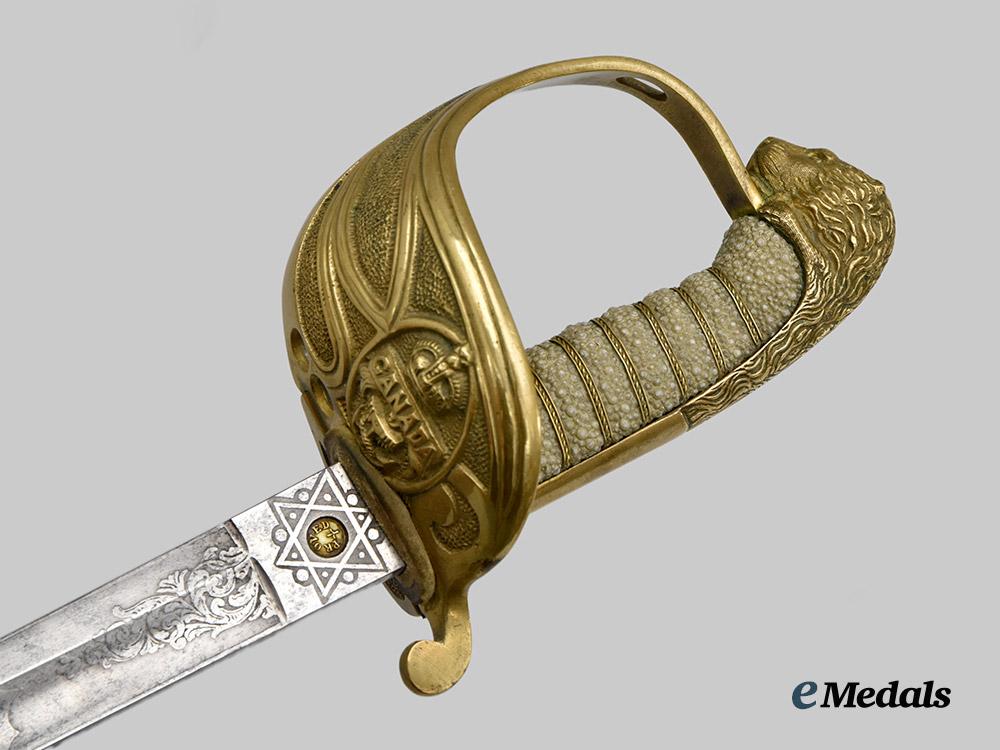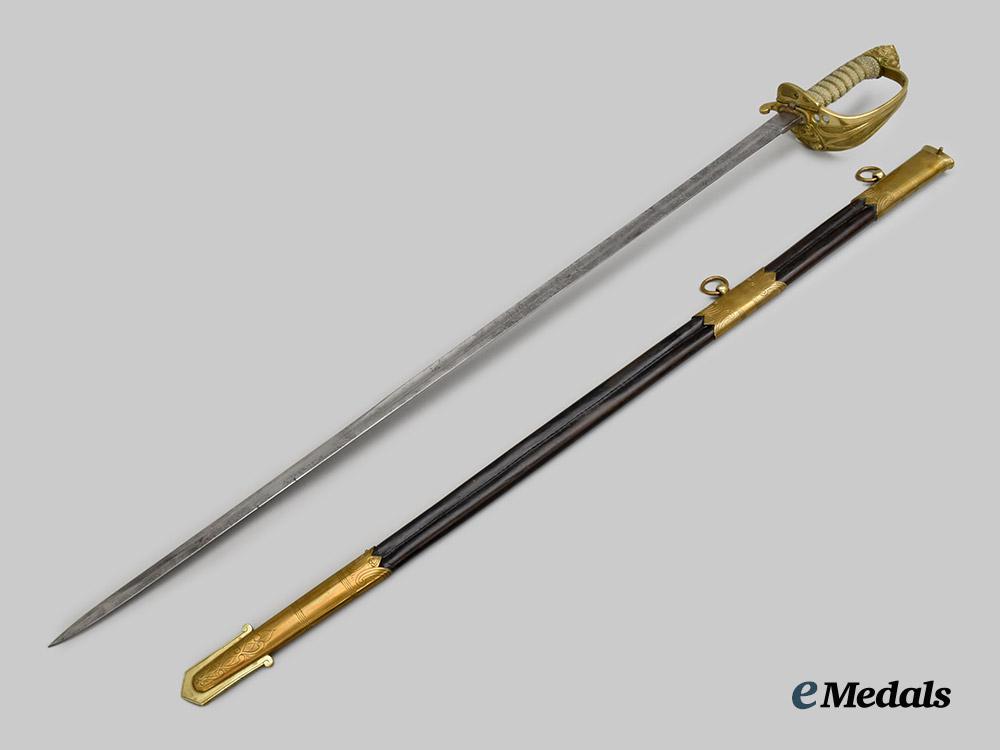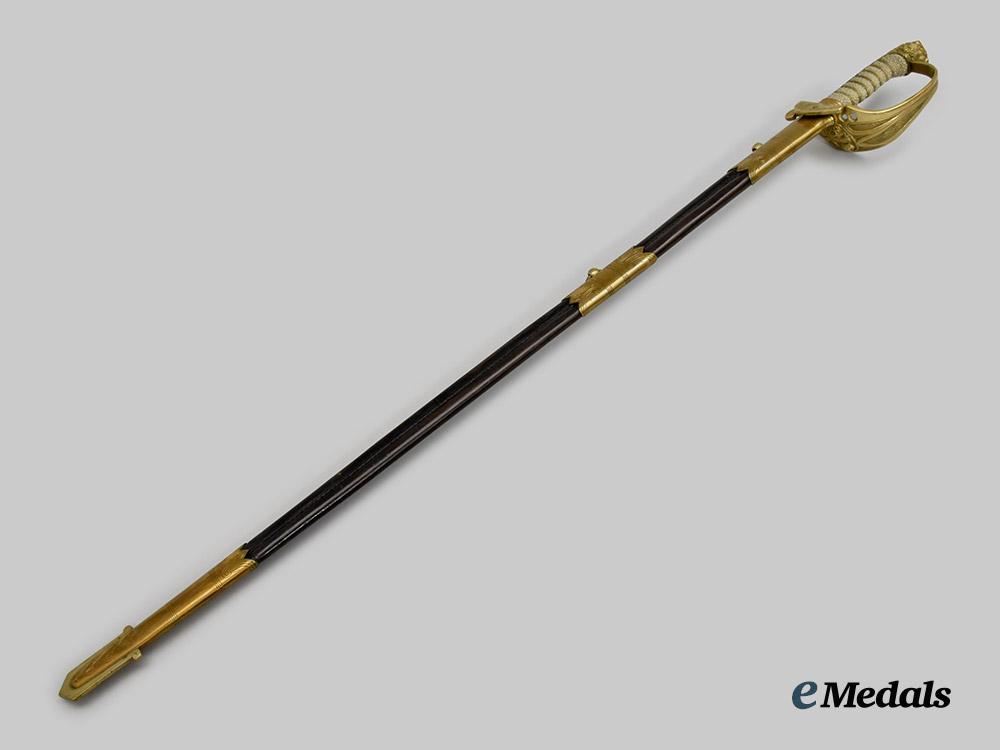
LOADING ...
In response to evolving domestic opinion, eMedals Inc has made the conscious decision to remove the presentation of German Third Reich historical artifacts from our online catalogue. For three decades, eMedals Inc has made an effort to preserve history in all its forms. As historians and researchers, we have managed sensitive articles and materials with the greatest of care and respect for their past and present social context. We acknowledge the growing sentiments put forth by the Canadian public and have taken proactive actions to address this opinion.












Canada. An Extremely Rare Naval Fisheries Protection Service Officer's Sword, by C.J. Weldon of London, 1910
Canada. An Extremely Rare Naval Fisheries Protection Service Officer's Sword, by C.J. Weldon of London, 1910
SKU: ITEM: C6856
Current Bid:
Your Max Bid:
Bid History:
Time Remaining:
Couldn't load pickup availability
Shipping Details
Shipping Details
eMedals offers rapid domestic and international shipping. Orders received prior to 12:00pm (EST) will be shipped on the same business day.* Orders placed on Canadian Federal holidays will be dispatched the subsequent business day. Courier tracking numbers are provided for all shipments. All items purchased from eMedals can be returned for a full monetary refund or merchandise credit, providing the criteria presented in our Terms & Conditions are met. *Please note that the addition of a COA may impact dispatch time.
Shipping Details
eMedals offers rapid domestic and international shipping. Orders received prior to 12:00pm (EST) will be shipped on the same business day.* Orders placed on Canadian Federal holidays will be dispatched the subsequent business day. Courier tracking numbers are provided for all shipments. All items purchased from eMedals can be returned for a full monetary refund or merchandise credit, providing the criteria presented in our Terms & Conditions are met. *Please note that the addition of a COA may impact dispatch time.
Description
Description
An extremely rare sword, it features a steel blade, magnetic, with a very sharp tip. Both sides of the blade have a fuller running from the mid-point to just above the ricasso and incorporates an ornate leafing and floral pattern. The obverse ricasso bears a brass proofmark disk inscribed "PROVED", while the reverse ricasso is maker marked "C.J. WELDON / 130-131 CHEAPSIDE / LONDON E.C.". The obverse of the blade is emblazoned with a ribbon banner inscribed "CANADA", with the King's crown surmounted by emanating rays above and a fouled anchor below, while the reverse of the blade has the Canadian coat-of-arms, with the King's crown surmounted by emanating rays above and the monogram of King Edward VII below. The blade exhibits scattered tarnishing and spotting, however, the blade itself remains clean and free of rust, measuring 820 mm in length. The blade is embedded into the hilt and is firm to it, with an oval-shaped brown leather washer at its base. The guard is in brass, decorated in large swirls on its upper, with two circular voided areas beside the blade, along with a voided slot near the entrance to the pommel. The upper of the guard houses an oval-framed insignia bearing "CANADA" with the King's crown above and a fouled anchor below, complemented by a short upward-facing curled quillon. Opposite the insignia is a flip-up panel with die-hole that is hinged to the guard itself, the die-hole designed to secure it to the pin on the locket of the scabbard near the throat. The brass ferrule butting the grip is designed with four rows of horizontal bands, the grip itself in a grayish shagreen wrap and incorporates seven rows of brass wire in the recessed areas, each row consisting of three wires: a single row of twisted wire flanked by single strands of straight wire on either side. The pommel is finished in a well-detailed beaver head, its mane forming a good proportion of the adjoining spine of the handle, the entire sword inclusive of its blade and handle measuring 955 mm in length. The accompanying sword is housed in its original black-finished, leather-wrapped scabbard, with a well-stitched seam on its reverse, along with incorporating a locket, mid-band and chape in brass, all three of which exhibit ornate swirls and rules and are secured to the body of the scabbard via a single pin. The locket and mid-band have large ball finials incorporating large brass rings used to suspend the sword from the wearer's belt. The chape is finished with a flattened u-shaped framework on three sides, the chape's framework designed with swirls on its two ends. It exhibits light wear and discolouration in the black-finished leather body, along with light contact and wear in the brass fixtures, is free of dents, the scabbard measuring 830 in length. Better than very fine, extremely rare, and a true Canadian treasure.
Footnote: Established following the introduction of the Naval Service Act by Prime Minister Sir Wilfrid Laurier, during the reign of King Edward VII, the Naval Service of Canada (NSC) was intended as a distinct naval force for Canada, that, should the need arise, could be placed under British control. The bill received Royal Assent on May 4, 1910.
The possibility of a Fisheries Department emerged in the late 1880s following contentious interactions with the US, as American fishing crafts illegally entered Canadian territorial waters. The government organized a protection service of six to eight armed vessels, whose responsibilities included lighthouses and other aids to navigation and the regulation of civilian shipping. Ex–Royal Navy officers who the Canadian government hired to run the service and British officials in Canada saw the possibilities for developing the fisheries protection service into a naval force.The Fisheries Protection Service was established in the early 1900s. Following this Naval Service Act, these “naval” components of Marine and Fisheries—the Fisheries Protection Service, the Hydrographic Survey, Tidal and Current Survey, and the Wireless Radiotelegraph organization of coastal radio stations for ship to shore communications—were transferred to the new department.
Description
An extremely rare sword, it features a steel blade, magnetic, with a very sharp tip. Both sides of the blade have a fuller running from the mid-point to just above the ricasso and incorporates an ornate leafing and floral pattern. The obverse ricasso bears a brass proofmark disk inscribed "PROVED", while the reverse ricasso is maker marked "C.J. WELDON / 130-131 CHEAPSIDE / LONDON E.C.". The obverse of the blade is emblazoned with a ribbon banner inscribed "CANADA", with the King's crown surmounted by emanating rays above and a fouled anchor below, while the reverse of the blade has the Canadian coat-of-arms, with the King's crown surmounted by emanating rays above and the monogram of King Edward VII below. The blade exhibits scattered tarnishing and spotting, however, the blade itself remains clean and free of rust, measuring 820 mm in length. The blade is embedded into the hilt and is firm to it, with an oval-shaped brown leather washer at its base. The guard is in brass, decorated in large swirls on its upper, with two circular voided areas beside the blade, along with a voided slot near the entrance to the pommel. The upper of the guard houses an oval-framed insignia bearing "CANADA" with the King's crown above and a fouled anchor below, complemented by a short upward-facing curled quillon. Opposite the insignia is a flip-up panel with die-hole that is hinged to the guard itself, the die-hole designed to secure it to the pin on the locket of the scabbard near the throat. The brass ferrule butting the grip is designed with four rows of horizontal bands, the grip itself in a grayish shagreen wrap and incorporates seven rows of brass wire in the recessed areas, each row consisting of three wires: a single row of twisted wire flanked by single strands of straight wire on either side. The pommel is finished in a well-detailed beaver head, its mane forming a good proportion of the adjoining spine of the handle, the entire sword inclusive of its blade and handle measuring 955 mm in length. The accompanying sword is housed in its original black-finished, leather-wrapped scabbard, with a well-stitched seam on its reverse, along with incorporating a locket, mid-band and chape in brass, all three of which exhibit ornate swirls and rules and are secured to the body of the scabbard via a single pin. The locket and mid-band have large ball finials incorporating large brass rings used to suspend the sword from the wearer's belt. The chape is finished with a flattened u-shaped framework on three sides, the chape's framework designed with swirls on its two ends. It exhibits light wear and discolouration in the black-finished leather body, along with light contact and wear in the brass fixtures, is free of dents, the scabbard measuring 830 in length. Better than very fine, extremely rare, and a true Canadian treasure.
Footnote: Established following the introduction of the Naval Service Act by Prime Minister Sir Wilfrid Laurier, during the reign of King Edward VII, the Naval Service of Canada (NSC) was intended as a distinct naval force for Canada, that, should the need arise, could be placed under British control. The bill received Royal Assent on May 4, 1910.
The possibility of a Fisheries Department emerged in the late 1880s following contentious interactions with the US, as American fishing crafts illegally entered Canadian territorial waters. The government organized a protection service of six to eight armed vessels, whose responsibilities included lighthouses and other aids to navigation and the regulation of civilian shipping. Ex–Royal Navy officers who the Canadian government hired to run the service and British officials in Canada saw the possibilities for developing the fisheries protection service into a naval force.The Fisheries Protection Service was established in the early 1900s. Following this Naval Service Act, these “naval” components of Marine and Fisheries—the Fisheries Protection Service, the Hydrographic Survey, Tidal and Current Survey, and the Wireless Radiotelegraph organization of coastal radio stations for ship to shore communications—were transferred to the new department.












You May Also Like
Germany, Third Reich. A Mixed Lot of Uniform Insignia
G59693
Germany, SS. A Set of Waffen-SS Legal Service Obersturmführer Shoulder Boards
G59692
Germany, Wehrmacht. A Spanish Cross in Gold, Exhibition Example by Rudolf Souval, c. 1960
G59688
Germany, Third Reich. An Order of the German Eagle, II Class Breast Star, by Gebrüder Godet
G59687
Slovakia, First Republic. A Rare and Mint Freiwillige Schutzstaffel Cap Insignia, Third Pattern, German-Made by Augustin Hicke
EU23583
-
Germany, Third Reich. A Mixed Lot of Uniform Insignia
G59693
Add to CartRegular price $225 USDRegular price $0 USD Sale price $225 USDUnit price / per -
Germany, SS. A Set of Waffen-SS Legal Service Obersturmführer Shoulder Boards
G59692
Add to CartRegular price $485 USDRegular price $0 USD Sale price $485 USDUnit price / per -
Germany, Wehrmacht. A Spanish Cross in Gold, Exhibition Example by Rudolf Souval, c. 1960
G59688
Add to CartRegular price $650 USDRegular price $0 USD Sale price $650 USDUnit price / per -
Germany, Third Reich. An Order of the German Eagle, II Class Breast Star, by Gebrüder Godet
G59687
Add to CartRegular price $2,650 USDRegular price $0 USD Sale price $2,650 USDUnit price / per -
Slovakia, First Republic. A Rare and Mint Freiwillige Schutzstaffel Cap Insignia, Third Pattern, German-Made by Augustin Hicke
EU23583
Add to CartRegular price $2,450 USDRegular price $0 USD Sale price $2,450 USDUnit price / per
Do you have a similar item you are interested in selling?
Please complete the form and our client care representatives will contact you.
Sell Item




























